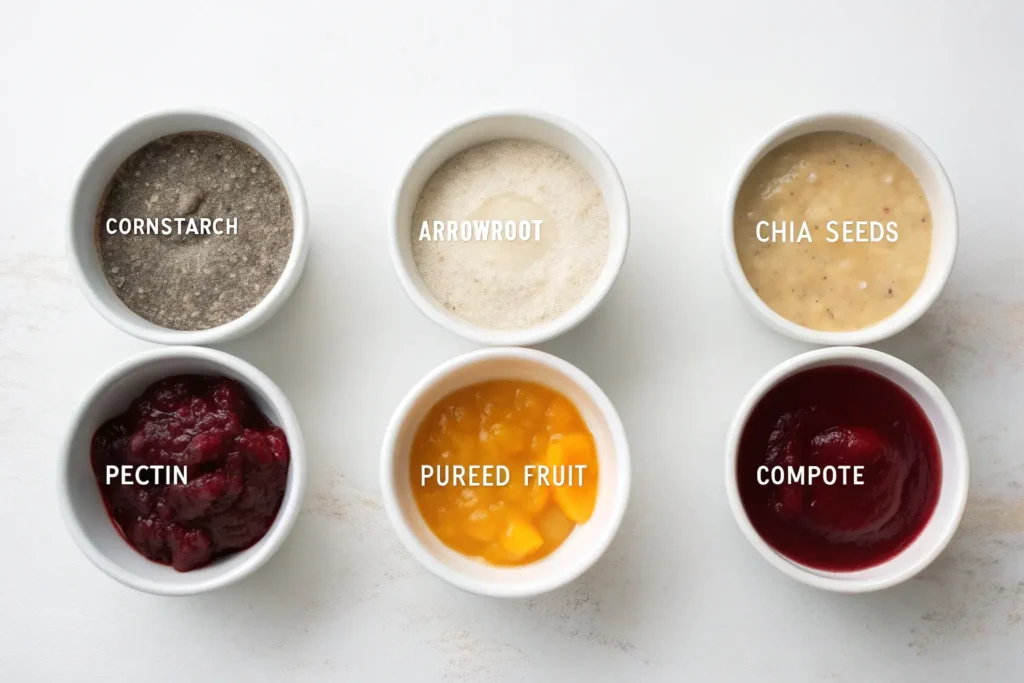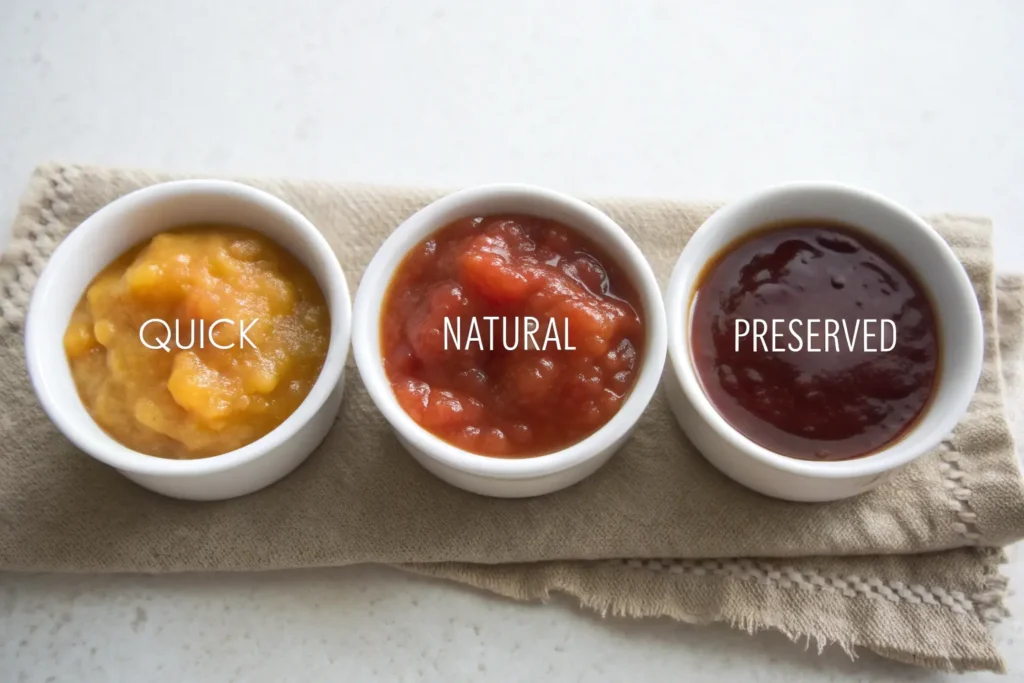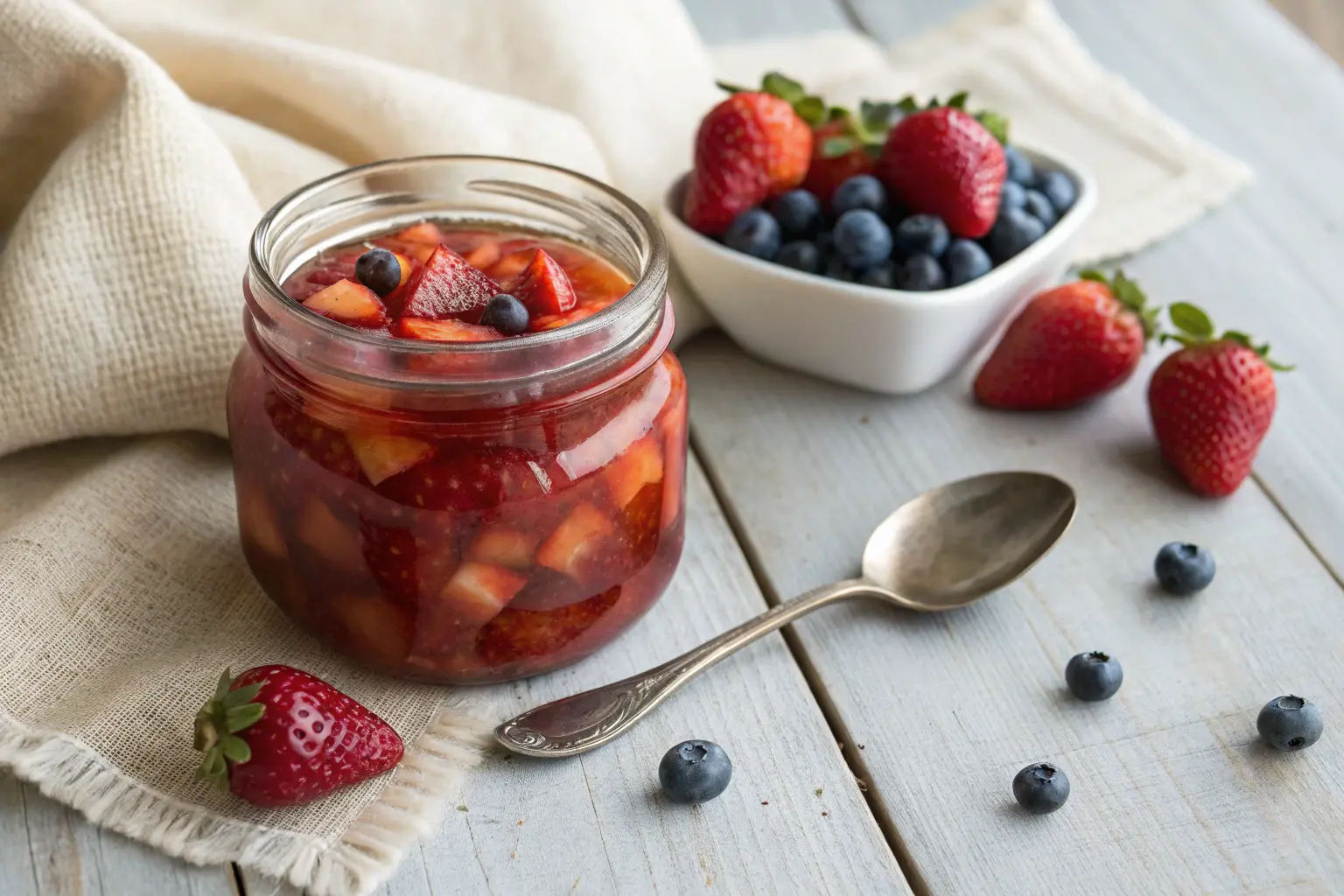How do you thicken fruit compote? Ever cooked up a batch of fruit compote, only to end up with a puddle of runny fruit sauce instead of the rich, glossy topping you were dreaming of? Yeah, same here. It’s one of those things that seems simple until you’re staring into a pot of watery berries wondering what went wrong.
The good news? Thickening fruit compote is totally doable—and you’ve got options. Whether you’re working with frozen fruit, fresh summer peaches, or those blueberries that have been chillin’ in your fridge a little too long, there’s a fix for that.
This guide breaks down exactly how to thicken fruit compote without messing up the flavor or texture. No weird ingredients. No fancy tools. Just straightforward, real-life kitchen tips that work—whether you’re topping pancakes, cheesecake, or spooning it straight from the jar (no judgment).
What Is Fruit Compote, Anyway?
Fruit compote is like jam’s easy-going cousin. It’s made by simmering fresh or frozen fruit with a little sugar, maybe some lemon juice or zest, and sometimes spices like cinnamon or vanilla. That’s it. No pectin, no hours of stirring, and way less sugar than jam.
You can keep it chunky or mash it down smooth. Use it warm or chilled. Spoon it over breakfast, dessert, or just sneak a bite out of the fridge. It’s super flexible, which is why it’s such a staple in my kitchen.
Fruit Compote vs. Jam vs. Syrup: When Thickening Matters
Let’s clear this up real quick because people use these terms like they’re all the same—and they’re not.
- Jam is cooked longer, usually with added pectin, and has a firm, spreadable texture.
- Syrup is thinner and more liquidy—more sugar, less fruit.
- Compote is that sweet spot in between. It’s chunky, juicy, and meant to spoon—not spread.
Compote gives you all the fruit flavor, but with a softer texture and a quicker cooking time.
Why and When You Need to Thicken Fruit Compote
Sometimes your fruit releases more water than you expected. Other times, you added a little too much lemon juice or wine or forgot to let it simmer long enough.
The result? Runny compote.
And that’s fine if you’re pouring it over pancakes and like it saucy. But if you want it to sit nicely on a slice of cheesecake or hold up on a biscuit, it needs a little body.
That’s when thickening comes in—not to fix a mistake, but to finish it off the right way.
How Do You Thicken Fruit Compote Without Changing the Flavor?

Method 1: How to Thicken Fruit Compote Naturally by Simmering
This is the OG method. No extra ingredients, just time and a little heat.
How to do it:
Once your fruit is soft and juicy, turn the heat down to medium-low and let it gently simmer. Keep the lid off so the steam escapes. Stir occasionally and let the liquid reduce naturally.
Why it works:
Evaporation slowly removes water, which concentrates both flavor and texture. You’ll end up with a thick, spoonable compote that doesn’t taste watery.
Best for: Any fruit. It’s the cleanest method if you want to keep your ingredient list short and sweet.
Method 2: How to Thicken Fruit Compote with Cornstarch
If your compote is done cooking and still runny, this is a quick fix.
How to do it:
In a small bowl, mix 1 tablespoon of cornstarch with 2 tablespoons of cold water. Stir until smooth, then pour it into your simmering compote. Cook for 1–2 minutes until it thickens.
Pro tip: Always mix cornstarch with cold water first. If you toss it straight into hot compote, it’ll clump up fast and get all lumpy.
Best for: Berry compotes, or when you’re short on time and need fast results.
Method 3: Use Arrowroot to Thicken Fruit Compote Without Cornstarch
Arrowroot is a great cornstarch alternative, especially if you’re avoiding corn or need a clearer finish.
How to do it:
Same as the cornstarch method—just use 1 tablespoon arrowroot mixed with 2 tablespoons cold water, then stir it into the hot compote and simmer briefly.
Why choose arrowroot?
It gives a shinier, more translucent finish and holds up better if you’re freezing or reheating the compote later.
Best for: Mixed fruit or citrus-heavy compotes.
Method 4: Thicken Fruit Compote with Chia Seeds for a Healthy Twist
This one’s for the health-conscious crowd—and it works surprisingly well.
How to do it:
Once your compote is done cooking, stir in 1 tablespoon of chia seeds per cup of fruit. Let it sit for 10–15 minutes. The seeds will swell up and naturally gel the compote.
Bonus: Chia adds fiber, omega-3s, and texture. It gives your compote a bit of crunch, so keep that in mind.
Best for: Blueberry, raspberry, or strawberry compotes, especially for yogurt parfaits or breakfast bowls.
Method 5: Using Pectin to Thicken Fruit Compote Like a Jam
If you’ve got pectin lying around from jam-making, a little goes a long way.
How to do it:
Use 1–2 teaspoons of pectin per batch. Mix with a bit of sugar and stir into the compote during the last few minutes of cooking.
Heads-up:
Pectin needs sugar and acid to activate, so this method works best if your compote already has both.
Best for: Fruit compotes that you want to preserve or store long-term.
Method 6: How Pureeing Fruit Can Thicken Your Fruit Compote
Here’s a sneaky one—use the fruit itself as the thickener.
How to do it:
Scoop out a portion of your cooked compote (about 1/3), blend it until smooth, and stir it back into the pot. It’ll naturally thicken the mixture while keeping all the fruity flavor.
Why it works:
Fruit contains natural fibers and sugars that create body when pureed.
Best for: Peach, pear, or apple-based compotes.
Choosing the Best Way to Thicken Fruit Compote (Quick Decision Guide)

For Quick Fixes: Cornstarch or Arrowroot
If your compote’s already cooked and you realize it’s too runny—this is your fix.
- Cornstarch is your go-to for a last-minute save.
- Arrowroot gives a silkier finish and works better if you plan to freeze or reheat.
Choose these if:
- You want to thicken your compote right now
- You’re serving it warm over pancakes, waffles, or ice cream
- You don’t mind using a thickener you probably already have in the pantry
Skip if: You’re trying to keep things super clean or starch-free.
For Healthier Options: Chia Seeds or Puree
These are great if you’re all about keeping it natural or boosting nutrition.
- Chia seeds give your compote extra fiber, protein, and healthy fats.
- Pureed fruit thickens naturally without anything added—just more of what you already love.
Choose these if:
- You’re using the compote for meal prep, yogurt bowls, or breakfast toppings
- You want to avoid starches or processed thickeners
- You love a little texture (chia seeds) or smooth fruit blends
Skip if: You want a super silky or classic-style finish.
For Preserving: Pectin or Slow Simmer
If you’re planning to can, store, or keep your compote on hand for a while—these two are your best friends.
- Pectin gives a jam-like thickness that holds up in jars.
- Simmering reduces moisture and deepens flavor naturally—ideal for long-term storage.
Choose these if:
- You’re making a big batch
- You want to keep it in the fridge for the week or freeze it
- You want a thick compote that won’t weep or separate
Skip if: You’re in a rush or making a small batch for right-now use.
Need an example?
Let’s say you’re topping a cheesecake with strawberry compote—cornstarch or arrowroot is perfect. But for oatmeal or yogurt? Go chia or puree.
Want something that lasts for weeks like a homemade blueberry compote-style topping? Simmer or use pectin for a more set texture that keeps well.
How to Avoid Ruining the Texture
Don’t Over-Stir or Over-Cook
Look, I get it—we all want to feel like we’re doing something when we’re at the stove. But when it comes to compote, stirring too much (especially once the thickener’s in) can actually break down the fruit too far or turn the texture pasty.
Here’s the move:
Stir gently and only as much as needed to prevent sticking. Once your thickener is in—like cornstarch, arrowroot, or even chia—just let it do its thing. Let it cook, not get beaten into mush.
Same goes for cooking time. If you keep simmering forever, you’ll break the fruit down too much and evaporate all the natural juices you actually want.
Avoid Clumps: How to Mix Thickeners Right
This one’s for all my fellow impatient cooks (yes, I’m calling myself out). If you’ve ever tossed flour, cornstarch, or arrowroot straight into a hot pan—you already know what happens. Clumps. Big, annoying, gummy clumps.
Here’s how to get it right:
- Always mix your thickener with cold water before adding it to your compote.
- Stir until it’s fully dissolved—no lumps, no weird textures.
- Then pour it into your compote while it’s simmering and stir gently until it thickens.
And if you’re working with a natural thickener like chia or puréed fruit, let it sit after stirring it in. It needs time to absorb or mix evenly.
Watch the Sugar Timing
If you add your sweetener (especially honey or maple syrup) too early, it can thin out your compote or mess with the thickening process.
Best move:
Let your fruit release its natural juices and cook down first. Then add your sugar or sweetener once it’s thickened slightly—especially if you’re using pectin, cornstarch, or arrowroot.
Let It Cool Before Judging the Texture
Compote thickens as it cools. That runny spoonful you panicked over? Give it 15–20 minutes and it might be perfect. Same with refrigerated compote—it sets up even more after a few hours in the fridge.
If you adjust too early, you might over-thicken and end up with fruit jelly instead of sauce.
Common Mistakes When Thickening Fruit Compote
Using Too Much Thickener
Let’s say you tossed in cornstarch, but it didn’t thicken fast enough, so you added more… and then a little more… and now it looks like fruit pudding. We’ve all been there.
Fix it:
You can usually fix over-thickened compote by adding a splash of water, juice, or even a little lemon juice—just a bit at a time. Warm it up gently and stir until it loosens to the texture you want.
Next time: Start small. One tablespoon of cornstarch is usually plenty for 2 cups of fruit. It thickens as it cools, so give it a minute before you add more.
Not Cooking It Long Enough
If you’ve added your thickener but still have runny compote, chances are it just needs another minute or two on the heat.
Why it happens:
Cornstarch and arrowroot need to simmer briefly to activate. If you just mix and remove from the stove too soon, it won’t get that glossy finish or hold its shape.
Fix it:
Put it back on low heat and stir gently until you see the texture tighten up. It only takes a couple of minutes.
Adding Sweetener Too Early
Sugar draws out water. If you add it before the fruit starts breaking down or before the thickener kicks in, it can flood the pan with extra juice and mess with your consistency.
Fix it:
No way to pull sugar back out, but you can let it reduce longer or add a teaspoon of chia or a bit of arrowroot to pull it back together.
Next time: Add sugar after the compote’s cooked down a bit—or use less to start, then adjust to taste.
Trying to Thicken with Flour (Don’t Do It)
Look, flour works for gravy—not fruit. It’ll give you a cloudy, gluey mess that coats your fruit in paste. Hard pass.
Instead use:
Cornstarch, arrowroot, or even instant tapioca if you’re in a pinch. They’re flavorless, dissolve clean, and don’t turn your sauce into pancake batter.
Not Matching the Method to the Fruit
Some fruits release way more juice than others. Watermelon, pineapple, grapes—they’re juicy and low in pectin. On the flip side, apples, berries, and plums thicken naturally with barely any help.
Fix it:
If you’re using watery fruit, plan to simmer longer or use a little extra thickener. If it’s a high-pectin fruit, try puréeing a bit of the fruit itself to thicken naturally without adding anything.
How to Store, Reheat, and Use Thickened Fruit Compote Like a Pro
Fridge Storage Tips (Short-Term)
Once your compote is cool, spoon it into a clean, airtight container and pop it in the fridge. It’ll stay fresh for up to 5–7 days.
Here’s the move:
- Let it cool completely before sealing the lid to avoid condensation.
- Use a glass jar or BPA-free plastic with a tight lid.
- Label it with the date so you’re not playing the “how old is this?” game later.
If it gets a little thicker in the fridge (totally normal), just stir in a spoonful of juice or water to loosen it back up.
Can You Freeze Thickened Compote?
Yes, totally! Just make sure it’s cooled all the way down first.
Here’s how to freeze it right:
- Divide into small containers or freezer bags (silicone bags are great for this).
- Leave a little space at the top—it’ll expand as it freezes.
- Label it with the fruit and the date.
You can freeze compote for up to 3 months. To use, thaw overnight in the fridge or reheat gently on the stove.
Bonus tip: Freeze in ice cube trays for single-serve portions—perfect for oatmeal or yogurt bowls.
Reheating Without Wrecking the Texture
To warm your compote without turning it into fruit glue:
- Use low heat on the stove. Add a splash of water or juice if it’s too thick.
- Microwave in 20-second bursts, stirring between rounds.
Avoid high heat—especially if you used a starch like cornstarch or arrowroot. Those can break down and get watery or weird if overheated.
Best Ways to Use Fruit Compote (So It Doesn’t Just Sit There)
Now for the fun part: how to serve up your compote like a pro. You didn’t go through all that effort just to let it hang out in the back of the fridge, right?
Breakfast Ideas:
- Spoon it over pancakes, waffles, or French toast
- Swirl into Greek yogurt, oatmeal, or overnight oats
- Spread it on toast or English muffins with almond butter
Dessert Wins:
- Drizzle over cheesecake, ice cream, or pound cake
- Layer it in parfaits or mix it into whipped cream for a quick mousse
- Use as a fruity filling between cake layers
Savory Surprises:
- Serve cherry or apple compote with roast chicken or turkey.
- Top baked brie or goat cheese with warm compote for an easy app
Seriously, the options are endless—and now you’ve got a thick, velvety compote that stays put where you want it.
Print
How Do You Thicken Fruit Compote? 6 Foolproof Fixes
- Total Time: 20 minutes
- Yield: About 2 cups
Description
Tired of runny fruit compote? Here’s exactly how to thicken it without ruining the flavor—no weird ingredients, just real kitchen fixes that work.
Ingredients
- Fresh or frozen fruit (berries, peaches, apples, etc.)
- Sugar or sweetener of choice
- Optional: lemon juice, zest, vanilla, cinnamon
- For thickening: cornstarch, arrowroot powder, chia seeds, or pectin
- Water (for mixing thickeners)
Instructions
- Simmer fruit with sugar and flavorings over medium heat until soft and juicy.
- Option 1: Reduce by simmering uncovered until thickened naturally.
- Option 2: Mix 1 tbsp cornstarch or arrowroot with 2 tbsp cold water, stir into compote, and simmer 1–2 minutes until thick.
- Option 3: Stir in 1 tbsp chia seeds per cup of fruit and let sit 10–15 minutes to gel.
- Option 4: Blend 1/3 of the cooked compote and stir back in for natural thickening.
- Option 5: Add 1–2 tsp pectin with sugar at end of cooking for jam-like texture.
- Let compote cool—thickness will increase as it sets.
Notes
Choose your thickening method based on the fruit type, time available, and how you’ll use the compote. Always mix thickeners with cold water first to avoid lumps.
- Prep Time: 5 minute
- Cook Time: 15 minutes
- Category: Breakfast
- Method: Stovetop
- Cuisine: Universal
Nutrition
- Serving Size: 2 Cups
- Calories: 35
- Sugar: 6g
- Sodium: 1mg
- Fat: 0g
- Saturated Fat: 0g
- Unsaturated Fat: 0g
- Trans Fat: 0g
- Carbohydrates: 8g
- Fiber: 1g
- Protein: 0g
- Cholesterol: 0mg
Conclusion: How Do You Thicken Fruit Compote?
So, next time your fruit compote turns out runnier than you expected—don’t panic. You’ve got plenty of easy, foolproof ways to thicken it up without wrecking the flavor. Whether you simmer it down old-school style, stir in a little cornstarch, or go the healthy route with chia seeds, it’s all about choosing what works best for your fruit, your vibe, and how you plan to serve it.
You’ve also got the tips to avoid lumpy textures, fix a too-thick batch, and store it like a pro—so whether it’s spooned over pancakes, layered in a parfait, or saved for next weekend’s brunch, your compote’s gonna come out just right.
Now that you’ve got the confidence and the kitchen tricks, go ahead—grab that bag of berries or those soft peaches on your counter. Fruit compote’s not just a topping—it’s a flex.
FAQs: Answers to How Do You Thicken Fruit Compote Questions
How do I thicken fruit compote?
The easiest ways to thicken fruit compote are simmering it longer, adding a cornstarch or arrowroot slurry, stirring in chia seeds, or blending part of the fruit to thicken naturally. Each one works depending on how thick you want it and how fast you need it done.
How to thicken fruit compote without cornstarch?
Skip the starch and try reducing the compote by simmering it with the lid off, or mix in chia seeds and let it sit. You can also puree some of the fruit and stir it back in—it’ll thicken without changing the flavor much.
How to loosen up compote?
If your compote turned out too thick, add a splash of water, fruit juice, or lemon juice and stir it in gently while warming it back up. A little goes a long way, so add slowly until the texture feels right.
How do you thicken fruit fillings without cornstarch?
Use arrowroot powder, pectin, or chia seeds. You can also cook the fruit longer to reduce the liquid, or mash some of the fruit to create a thicker base without any added starch at all.
What is the thickening agent for fruit jam?
Most jams use natural fruit pectin as a thickener, sometimes boosted with lemon juice (for acid) and sugar to help it set. If your fruit is low in pectin, powdered pectin or a longer cooking time usually does the trick.
How to make the best fruit compote?
Use ripe, flavorful fruit, just enough sugar to balance the tartness, and a splash of lemon juice for brightness. Cook low and slow to release the juices, then thicken it to your liking using one of the methods above. Fresh herbs or warm spices like cinnamon or vanilla are great finishing touches.

